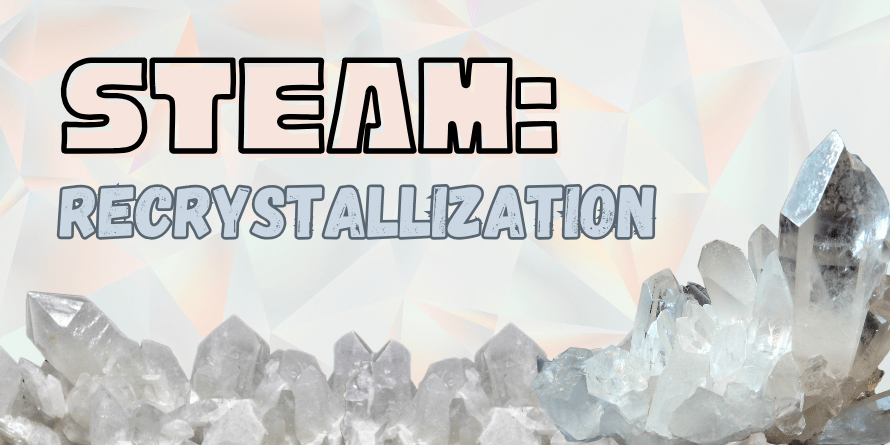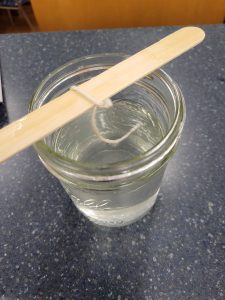
Did you know that minerals can ”grow” in water? It is called recrystallization, and you can see it happen in your own home!
Materials
- ½ cup of tap or distilled water
- Salt (table salt, epsom salt, or alum salt)
- Small pan to heat water
- Spoon or whisk
- String
- Clear heat-safe jar (ex: a mason jar)
- Pencil or popsicle stick
- Grown-up to help

Method
- Have an adult heat a pan of water until it begins to bubble.
- Take the pan off the heat.
- Pour about ½ cup of salt into the water and stir until the water is clear. If you don’t see any salt grains in the water, stir in another spoonful. Keep stirring in salt until you see salt grains that won’t dissolve when stirred.
- Have your adult slowly pour the hot water into a clear jar. Stop before the salt grains fall into the jar. If undissolved salt grains are in the jar, the crystals might grow around those instead of your string. This happened in our experiment; you can see the crystals in this photo.

- Tie a string around a pencil or popsicle stick. The string should have tiny grooves and rough edges so that the salt can latch on. A braided string is better than a fishing line. The pencil or popsicle stick should be long enough to lie across the top of the jar.

- Cut the string to the correct size to dangle in the water. Only the portion of the string underneath the water will grow crystals.
- Balance the pencil or popsicle stick on top of the glass jar. The string should hang inside the jar and extend into the water. Tape the pencil/popsicle stick if it won’t stay put. Don’t let the string touch the side of the jar.
- Move the jar to a safe place where it will be undisturbed.
- Check on it often to see if the crystals have started to form.

Why Did This Happen?
The molecules in the water move faster when heated, allowing more salt to be absorbed than usual. This is called a supersaturated solution.
Recrystallization occurs as the water cools and evaporates, allowing the salt to come out of the solution and form crystals.
During the recrystallization process, the atoms that make up salt bond together and attach to the nearest solid. After the initial crystallization occurs, the atoms will bond to the crystals.
Notes for Success
- Do not let the string touch the bottom of the jar. If the string goes all the way to the bottom, the crystal will be lumpy and small.
- Be patient! Table salt can take days, if not a week, to start to form. Once the crystals start forming, they will get bigger and bigger during the next couple of weeks.
- Try using the other types of salts and see if there is a difference in the size of the crystals or how long it takes for them to form.
- Another way to adjust this experiment is to add two drops of food coloring to the water before adding the string. Does it change the crystals?
- Repeat the experiment with other materials to see what else can grow crystals in the salt water.
- To grow a lumpy mass of crystals, keep the jar in the sun or have a fan blowing near it on the lowest setting. These crystals won’t get too large.
- Keep the jar in a cool, shaded place to grow a single, large crystal. Keep it on Styrofoam or a similar material to absorb vibrations.
- Epsom salt will grow faster in the refrigerator than it will in the sun.
This experiment was borrowed from the Girl Scouts of Eastern Oklahoma.


Add a comment to: STEAM: Recrystallization